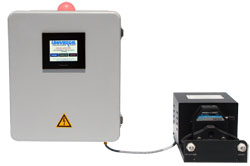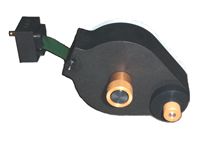All
coding and printing systems depend on a continuous source of ink for proper
operation. Although the ink demands of most normal coding applications can
be met with pre-saturated ink rolls, high speed web printing applications
can rapidly tax the capacity of most inking systems. A perfect ink supply
system would feed ink to the coder in precisely metered volumes on an as
needed basis and would be programmable to meet the demands of both high
and low density code printing requirements. For maximum marking economy,
the ink supply system should accommodate ink purchased in bulk containers.
The last but perhaps the most important design criteria would be that the
system should require only minimal maintenance. Universal met this design
challenge with the new PIDS-DIGITAL Programmable Ink Delivery Systems.
Universal's
New PIDS-DIGITAL Programmable Ink Delivery
Systems were developed to accurately feed ink to
our Non-Porous Coders in high speed web printing applications. When web speeds
exceed 400 fpm or code density exceeds the ability of our 4 oz. Reservoir
Ink Cartridges to deliver adequate ink volumes - the PIDS-DIGITAL Systems
provide the optimal solution.

The
New
PIDS-DIGITAL Control was totally redesigned to offer
greatly enhanced functionality over the previous generation of the product
line. A high resolution color touch screen coupled with a powerful PLC operates
the system on an encoder pulse based program to provide very user friendly
programming and the ultimate in inking system accuracy. To eliminate the need
to install a seperate encoder on the web to monitor web velocity, a simple
modification to one of the attached printers enables the printer to provide
web velocity data to the control during operation. This new capability provides
automatic adjustment of the pump output to compensate for changes in web velocity
during production. Interface to the web feed controls is no longer necessary
to stop ink delivery when the web motion stops - this is now an automatic
function.
The powerful control on
the new PIDS-DIGITAL Systems, not only provides extremely accurate ink delivery
but it also provides other enhanced features. New capabilities include automatic
monitoring and display of web velocity. Ink consumption rates are calculated
and displayed in milliters per 1,000 yards of print based on the current program.
A pump tube hour meter alerts the operator when the pump tubes have reached
1,000 hours of operation and require changing. A low level ink sensor alerts
the operator when the reservoir needs to be refilled. A two color LED light
on top of the control provides a high visibility signal to the operator when
an alarm condition exists.
The
PIDS-DIGITAL Systems are available with 1, 2, 3 & 4 head pump modules
for single or gang mount printer applications.
The
PIDS-DIGITAL Pump Modules:
Following the design criteria to produce the ultimate coder ink delivery system,
Universal's design team selected peristaltic metering pumps for use on the PIDS-DIGITAL
Systems. These tube pumps are geared and programmed to deliver ink to the printers
in 1.1 ml shots at programmed intervals during the printing operation. A distinct
advantage of the peristaltic pump design is that no ink contacts any of the
pumps moving parts. The only maintenance required on these pumps is the periodic
changing of the pump tubes. Raising a lever on the pump head un-clamps the pump
tube and pressing two release buttons on the quick change tube couplings frees
the pump tube assembly. This unique system enables tube changes in less than
10 seconds.




The
Coder Connection The final challenge in the development
of the Programmable Ink Delivery System design was finding an effective method
of transferring ink from the pump to the ink roll without compromising print
quality or increasing maintenance requirements. To accomplish this task, Universal
developed a unique wiper adapter assembly with no moving parts. Ink is injected
between two thin plastic wipers which wipe the ink completely across the face
of the rotating ink rolls. Cycling the pump at regular intervals and injecting
very small volumes of ink per cycle, ensures that the printer maintains uniform
print density.




